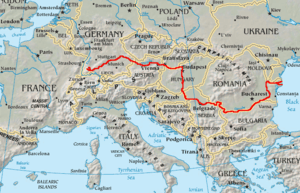Island of Vukovar
| Disputed island Other names: Vukovarska ada | |
|---|---|
| Geography | |
| Location | Danube River |
| Coordinates | 45°20′50″N 19°01′48″E / 45.34722°N 19.03000°ECoordinates: 45°20′50″N 19°01′48″E / 45.34722°N 19.03000°E |
| Total islands | 1 |
| Administered by | |
| Serbia | |
| Claimed by | |
| Croatia | |
| Serbia | |
The Island of Vukovar (Serbo-Croatian: Vukovarska ada / Вуковарска ада, pronounced [ʋûkoʋaːrskaː ǎːda] or [-ǎda]) is a disputed island on the river Danube. It is situated close to the city of Vukovar.
During the existence of SFR Yugoslavia this island was part of SR Croatia. In the Croatian War of Independence, the Yugoslav People's Army and Serbian paramilitary forces occupied the island.
In 1991 Croatia became independent. It was the opinion of the Badinter Arbitration Committee that the borders between the republics should become the borders between the countries,[1] but it was under Serbian control like other parts of Eastern Slavonia, Baranja and Western Srem (east Croatia) at the time.
After the Erdut Agreement in 1998, Eastern Slavonia, Baranja and Western Srem were rejoined with Croatia, but the island of Vukovar was left under Serbian military occupation. A similar situation has happened with the Island of Šarengrad.
In 2004 Serbia mostly withdrew its army from the island,[2] but the police completely took over border control only in 2006.[3]
In 2006, the island's beaches were opened to the public for the first time since the Croatian War of Independence.[4] The island is maintained by Vukovar's Sports Recreation Society Dunav.[5] For the first time in 16 years, Croatian citizens were allowed on the island without passports or border permits. This border regime applies during summer months (until September 15) between 7 a.m and 8 p.m.[4]
One part of the peace agreements has been the short term deal that Croatia will control the western part and Serbia eastern part of the Danube.[6] The official Serbian position is that Badinter Arbitration Committee opinion is not valid and that this short term deal between Croatia and Serbia will become the future border between the states so that the island of Vukovar is part of Serbia because it is nearer to Serbian coast of Danube, while Danube is navigable only from side toward Croatia.[7]
In his a statement for daily newspaper Novi list in February 2012 Croatian President Ivo Josipović said that countries need flexible solution for border disputes on Danube river that would be combination of solutions proposed by two countries.[8] Croatian president said whatever solution would be adopted it would be good that Island of Vukovar eventually found on the Croatian side of border.[8] In his statement President made no mention of the second disputed Danube island, Island of Šarengrad.[8]
References
- ↑ Decision of Badinter committee
- ↑ "Uskoro trajekt Vukovar - Bač" (in Serbian). Prosvjeta. 2005. Retrieved 2011-01-05.
Na sastanku je, pored ostalog, postavljeno i pitanje ko iz SCG kontroliše granicu sa Hrvatskom. Bogunović je rekao da vojska to ne čini već više od dve godine, a na njihovom mestu je policija Bača na razdaljini od oko 40 kilometara i Centar za carinu u Bačkoj Palanci.
- ↑ "Srpska vojska povukla se s granice s Hrvatskom". Jutarnji list (in Croatian). 2006-10-30. Retrieved 2011-01-05.
- ↑ 4.0 4.1 Vukovarska Ada nakon 16 godina otvorena za kupanje
- ↑ Lani na adi izbrojali 130.000 kupača, Vjesnik
- ↑ Map of island and provisional deal on Croatian
- ↑ Serbian refusal of Badinter Arbitration Committee decision on Serbian
- ↑ 8.0 8.1 8.2 http://www.b92.net/info/vesti/index.php?yyyy=2012&mm=02&dd=29&nav_category=11&nav_id=586813
| |||||||||||||||||||||||||
